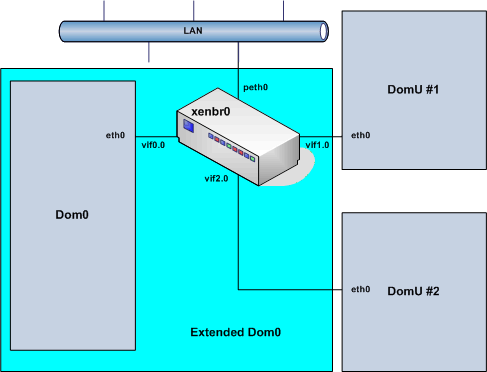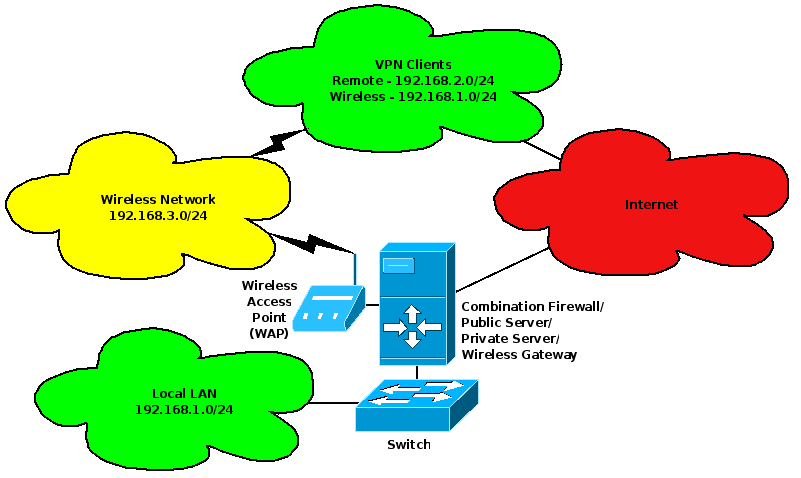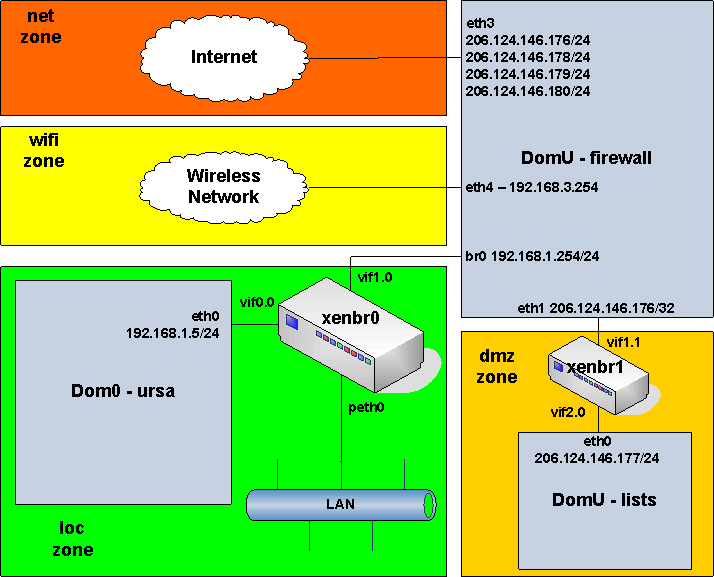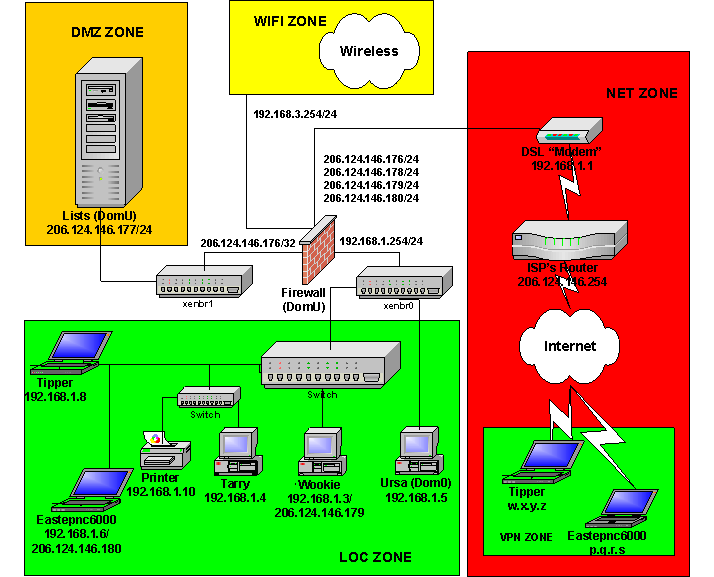Copyright © 2006, 2007 Thomas M. Eastep
Permission is granted to copy, distribute and/or modify this document under the terms of the GNU Free Documentation License, Version 1.2 or any later version published by the Free Software Foundation; with no Invariant Sections, with no Front-Cover, and with no Back-Cover Texts. A copy of the license is included in the section entitled “GNU Free Documentation License”.
2020/04/17
Table of Contents
Caution
This article applies to Shorewall 3.0 and later. If you are running a version of Shorewall earlier than Shorewall 3.0.0 then please see the documentation for that release.
Xen is a paravirtualization tool that allows you to run multiple virtual machines on one physical machine. It is available on a wide number of platforms and is included in recent SUSE™ distributions.
Xen refers to the virtual machines as Domains. Domains are numbered with the first domain being domain 0, the second domain 1, and so on. Domain 0 (Dom0) is special because that is the domain created when the machine is booted. Additional domains (called DomU's) are created using the xm create command from within Domain 0. Additional domains can also be created automatically at boot time by using the xendomains service.
Xen virtualizes a network interface named eth0[1]in each domain. In Dom0, Xen also creates a bridge (xenbr0) and a number of virtual interfaces
as shown in the following diagram.

I use the term Extended Dom0 to distinguish the bridge and virtual interfaces from Dom0 itself. That distinction is important when we try to apply Shorewall in this environment.
The bridge has a number of ports:
peth0 — This is the port that connects to the physical network interface in your system.
vif0.0 — This is the bridge port that is used by traffic to/from Domain 0.
vifX.0 — This is the bridge port that is used by traffic to/from Domain X.
Prior to adopting Xen, I had a home office crowded with 5 systems, three monitors a scanner and a printer. The systems were:
Firewall
Public Server in a DMZ (mail)
Private Server (wookie)
My personal Linux Desktop (ursa)
My work system (docked laptop running Windows XP).
The result was a very crowded and noisy room.
Xen has allowed me to reduce the noise and clutter considerably. I now have three systems with two monitors. I've also replaced the individual printer and scanner with a Multifunction FAX/Scanner/Printer.
The systems now include:
Combination Firewall/Public Server/Private Server/Wireless Gateway using Xen (created by building out my Linux desktop system).
My work system.
My Linux desktop (wookie, which is actually the old public server box)
Most of the Linux systems run SUSE ™10.1; my personal Linux desktop system and our Linux Laptop run Ubuntu™ "Dapper Drake".
The configuration described below uses a bridged Xen Networking configuration; if you want to see how to accomplish a similar configuration using a Routed Xen configuration then please see this article. I am now using the routed configuration because it results in one fewer domains to administer.
Here is a high-level diagram of our network.

As shown in this diagram, the Xen system has three physical network interfaces. These are:
eth0-- connected to the switch in my office. That switch is cabled to a second switch in my wife's office where my wife has her desktop and networked printer (I sure wish that there had been wireless back when I strung that CAT-5 cable halfway across the house).eth1-- connected to our DSL "Modem".eth2-- connected to a Wireless Access Point (WAP) that interfaces to our wireless network.
There are three Xen domains.
Dom0 (DNS name ursa.shorewall.net) is used as a local file server (NFS and Samba).
The first DomU (Dom name firewall, DNS name gateway.shorewall.net) is used as our main firewall and wireless gateway.
The second DomU (Dom name lists, DNS name lists.shorewall.net) is used as a public Web/FTP/Mail/DNS server.
Shorewall runs in Dom0 and in the firewall domain.
Caution
As the developer of Shorewall, I have enough experience to be very comfortable with Linux networking and Shorewall/iptables. I arrived at this configuration after a fair amount of trial and error experimentation. If you are a Linux networking novice, I recommend that you do not attempt a configuration like this one for your first Shorewall installation. You are very likely to frustrate both yourself and the Shorewall support team. Rather I suggest that you start with something simple like a standalone installation in a domU; once you are comfortable with that then you will be ready to try something more substantial.
As Paul Gear says: Shorewall might make iptables easy, but it doesn't make understanding fundamental networking principles, traffic shaping, or multi-ISP routing any easier.
The same goes for Xen networking.
Below are the relevant configuration files for the three domains. I use partitions on my hard drives for DomU storage devices.
/boot/grub/menu.lst— here is the entry that boots Xen in Dom0.title XEN root (hd0,1) kernel /boot/xen.gz dom0_mem=458752 sched=bvt module /boot/vmlinuz-xen root=/dev/hda2 vga=0x31a selinux=0 resume=/dev/hda1 splash=silent showopts module /boot/initrd-xen
/etc/modprobe.conf.local
eth1(PCI 00:09.0) andeth2(PCI 00:0a.0) are delegated to the firewall DomU where they becomeeth3andeth4respectively. The SUSE 10.1 Xen kernel compiles pciback as a module so the instructions for PCI delegation in the Xen Users Manual can't be followed directly (see http://wiki.xensource.com/xenwiki/Assign_hardware_to_DomU_with_PCIBack_as_module).options pciback hide=(00:09.0)(00:0a.0) install tulip /sbin/modprobe pciback ; /sbin/modprobe --first-time --ignore-install tulip options netloop nloopbacks=1
/etc/xen/auto/01-firewall— configuration file for the firewall domain# -*- mode: python; -*- # configuration name: name = "firewall" # usable ram: memory = 384 # kernel and initrd: kernel = "/xen2/vmlinuz-xen" ramdisk = "/xen2/initrd-xen" # boot device: root = "/dev/hdb2" # boot to run level: extra = "3" # network interface: vif = [ 'mac=aa:cc:00:00:00:02, bridge=xenbr0', 'mac=aa:cc:00:00:00:03, bridge=xenbr1' ] # Interfaces delegated from Dom0 pci=[ '00:09.0' , '00:0a.0' ] # storage devices: disk = [ 'phy:hdb2,hdb2,w' ]
/etc/xen/auto/02-lists— configuration file for the lists domain# -*- mode: python; -*- # configuration name: name = "lists" # usable ram: memory = 512 # kernel and initrd: kernel = "/xen2/vmlinuz-xen" ramdisk = "/xen2/initrd-xen" # boot device: root = "/dev/hda3" # boot to run level: extra = "3" # network interface: vif = [ 'mac=aa:cc:00:00:00:01, bridge=xenbr1' ] hostname = name # storage devices: disk = [ 'phy:hda3,hda3,w' ]
With all three Xen domains up and running, the system looks as shown in the following diagram.

The zones correspond to the Shorewall zones in the firewall DomU configuration.
Note
If you want to run a simple NAT gateway in a Xen DomU, just omit the second bridge (xenbr1), the second delegated interface, and the second DomU from the above configuration. You can then install the normal Shorewall two-interface sample configuration in the DomU.
Caution
Under some circumstances, UDP and/or TCP communication from a
domU won't work for no obvious reason. That happened with the
lists domain in my setup. Looking at
the IP traffic with tcpdump -nvvi eth1 in the
firewall domU showed that UDP packets
from the lists domU had incorrect
checksums. That problem was corrected by arranging for the following
command to be executed in the lists
domain when its eth0 device
was brought up:
ethtool -K eth0 tx off
Under SUSE 10.1, I placed the following in
/etc/sysconfig/network/if-up.d/resettx (that file
is executable):
#!/bin/sh
if [ $2 = eth0 ]; then
ethtool -K eth0 tx off
echo "TX Checksum reset on eth0"
fiUnder other distributions, the technique will vary. For example,
under Debian™ or Ubuntu™,
you can just add a 'post-up' entry to
/etc/network/interfaces as shown here:
iface eth0 inet static
address 206.124.146.177
netmask 255.255.255.0
post-up ethtool -K eth0 tx offCaution
Update. Under SUSE 10.2, communication from a domU works okay without running ethtool but traffic shaping in dom0 doesn't work! So it's a good idea to run it just to be safe.
SUSE 10.1 includes Xen 3.0.2 which supports PCI delegation. The network interfaces that connect to the net and wifi zones are delegated to the firewall DomU.
When Shorewall starts during bootup of Dom0, it creates the two
bridges using this /etc/shorewall/init extension
script:
for bridge in xenbr0 xenbr1; do
if [ -z "$(/sbin/brctl show 2> /dev/null | fgrep $bridge)" ]; then
/sbin/brctl addbr $bridge
/sbin/ip link set dev $bridge up
fi
doneThe goals for the Shorewall configuration in Dom0 are as follows:
Allow traffic to flow unrestricted through the two bridges. This is done by configuring the hosts connected to each bridge as a separate zone and relying on Shorewall's implicit intra-zone ACCEPT policy to permit traffic through the bridge.
Ensure that there is no stray traffic between the zones. This is a "belt+suspenders" measure since there should be no routing between the bridges (because they don't have IP addresses).
The configuration is a simple one:
/etc/shorewall/zones:#ZONE TYPE OPTIONS IN_OPTIONS OUT_OPTIONS fw firewall loc ipv4 dmz ipv4
/etc/shorewall/policy(Note the unusual use of an ACCEPT all->all policy):#SOURCE DEST POLICY LOGLEVEL LIMIT dmz all REJECT info all dmz REJECT info all all ACCEPT
/etc/shorewall/interfaces:#ZONE INTERFACE BROADCAST OPTIONS loc xenbr0 192.168.1.255 dhcp,routeback dmz xenbr1 - routeback
In the firewall DomU, I run a conventional three-interface firewall with Proxy ARP DMZ -- it is very similar to the firewall described in the Shorewall Setup Guide with the exception that I've added a fourth interface for our wireless network. The firewall runs a routed OpenVPN server to provide road warrior access for our two laptops and a bridged OpenVPN server for the wireless network in our home. Here is the firewall's view of the network:

The two laptops can be directly attached to the LAN as shown above or they can be attached wirelessly -- their IP addresses are the same in either case; when they are directly attached, the IP address is assigned by the DHCP server running in Dom0 and when they are attached wirelessly, the IP address is assigned by OpenVPN.
The Shorewall configuration files are shown below. All routing and secondary IP addresses are handled in the SUSE network configuration.
/etc/shorewall/shorewall.conf:
STARTUP_ENABLED=Yes VERBOSITY=0 LOGFILE=/var/log/firewall LOGFORMAT="Shorewall:%s:%s:" LOGTAGONLY=No LOGRATE= LOGBURST= LOGALLNEW= BLACKLIST_LOGLEVEL= MACLIST_LOG_LEVEL=$LOG TCP_FLAGS_LOG_LEVEL=$LOG SMURF_LOG_LEVEL=$LOG LOG_MARTIANS=No IPTABLES=/usr/sbin/iptables PATH=/sbin:/bin:/usr/sbin:/usr/bin:/usr/local/bin:/usr/local/sbin SHOREWALL_SHELL=/bin/bash SUBSYSLOCK= MODULESDIR= CONFIG_PATH=/etc/shorewall:/usr/share/shorewall RESTOREFILE=standard IPSECFILE=zones IP_FORWARDING=On ADD_IP_ALIASES=No ADD_SNAT_ALIASES=No RETAIN_ALIASES=No TC_ENABLED=Internal CLEAR_TC=Yes MARK_IN_FORWARD_CHAIN=Yes CLAMPMSS=Yes ROUTE_FILTER=No DETECT_DNAT_IPADDRS=Yes MUTEX_TIMEOUT=60 ADMINISABSENTMINDED=Yes BLACKLISTNEWONLY=Yes DELAYBLACKLISTLOAD=No MODULE_SUFFIX= DISABLE_IPV6=Yes BRIDGING=No DYNAMIC_ZONES=No PKTTYPE=No MACLIST_TTL=60 SAVE_IPSETS=No MAPOLDACTIONS=No FASTACCEPT=Yes BLACKLIST_DISPOSITION=DROP MACLIST_TABLE=mangle MACLIST_DISPOSITION=DROP TCP_FLAGS_DISPOSITION=DROP
/etc/shorewall/zones:#ZONE TYPE OPTIONS IN_OPTIONS OUT_OPTIONS fw firewall net ipv4 #Internet loc ipv4 #Local wired Zone dmz ipv4 #DMZ vpn ipv4 #Open VPN clients wifi ipv4 #Local Wireless Zone
/etc/shorewall/policy:#SOURCE DEST POLICY LOGLEVEL LIMIT $FW $FW ACCEPT $FW net ACCEPT loc net ACCEPT $FW vpn ACCEPT vpn net ACCEPT vpn loc ACCEPT loc vpn ACCEPT $FW loc ACCEPT wifi all REJECT $LOG loc $FW REJECT $LOG net $FW DROP $LOG 1/sec:2 net loc DROP $LOG 2/sec:4 net dmz DROP $LOG 8/sec:30 net vpn DROP $LOG all all REJECT $LOG
/etc/shorewall/params (edited):MIRRORS=<comma-separated list of Shorewall mirrors> NTPSERVERS=<comma-separated list of NTP servers I sync with> POPSERVERS=<comma-separated list of server IP addresses> LOG=info INT_IF=eth0 DMZ_IF=eth1 EXT_IF=eth3 WIFI_IF=eth4 OMAK=<IP address at our second home>
/etc/shorewall/init:echo 1 > /proc/sys/net/ipv4/netfilter/ip_conntrack_tcp_be_liberal
/etc/shorewall/interfaces:#ZONE INTERFACE BROADCAST OPTIONS net $EXT_IF 206.124.146.255 dhcp,logmartians,blacklist,tcpflags,nosmurfs dmz $DMZ_IF 192.168.0.255 logmartians loc $INT_IF 192.168.1.255 dhcp,routeback,logmartians wifi $WIFI_IF 192.168.3.255 dhcp,maclist vpn tun+ -
/etc/shorewall/nat:#EXTERNAL INTERFACE INTERNAL ALLINTS LOCAL 206.124.146.178 $EXT_IF 192.168.1.3 No No #Wookie 206.124.146.180 $EXT_IF 192.168.1.6 No No #Work LapTop
/etc/shorewall/masq (Note the cute trick here and in the. The leading "+" is required to place the rule before the SNAT rules generated by entries infollowing proxyarpfile that allows me to access the DSL "Modem" using its default IP address (192.168.1.1))/etc/shorewall/natabove.#INTERFACE SUBNET ADDRESS PROTO DPORT IPSEC +$EXT_IF:192.168.1.1 0.0.0.0/0 192.168.1.254 $EXT_IF 192.168.0.0/22 206.124.146.179
/etc/shorewall/proxyarp:#ADDRESS INTERFACE EXTERNAL HAVEROUTE PERSISTENT 192.168.1.1 $EXT_IF $INT_IF yes 206.124.146.177 $DMZ_IF $EXT_IF yes
/etc/shorewall/tunnels:#TYPE ZONE GATEWAY GATEWAY_ZONE openvpnserver:udp net 0.0.0.0/0 #Routed server for RoadWarrior access openvpnserver:udp wifi 192.168.3.0/24 #Home wireless network server
/etc/shorewall/actions:#ACTION Mirrors # Accept traffic from Shorewall Mirrors
/etc/shorewall/action.Mirrors:#TARGET SOURCE DEST PROTO PORT SPORT ORIGDEST RATE ACCEPT $MIRRORS
/etc/shorewall/rules:?SECTION NEW ############################################################################################################################################################################### #ACTION SOURCE DEST PROTO DPORT SPORT ORIGDEST RATE USER ############################################################################################################################################################################### REJECT:$LOG loc net tcp 25 REJECT:$LOG loc net udp 1025:1031 # # Stop NETBIOS crap # REJECT loc net tcp 137,445 REJECT loc net udp 137:139 # # Stop my idiotic work laptop from sending to the net with an HP source/dest IP address # DROP loc:!192.168.0.0/22 net ############################################################################################################################################################################### # Local Network to Firewall # DROP loc:!192.168.0.0/22 fw # Silently drop traffic with an HP source IP from my XP box ACCEPT loc fw tcp 22 ACCEPT loc fw tcp time,631,8080 ACCEPT loc fw udp 161,ntp,631 ACCEPT loc:192.168.1.5 fw udp 111 DROP loc fw tcp 3185 #SUSE Meta pppd Ping(ACCEPT) loc fw REDIRECT loc 3128 tcp 80 - !206.124.146.177 ############################################################################################################################################################################### # Road Warriors to Firewall # ACCEPT vpn fw tcp ssh,time,631,8080 ACCEPT vpn fw udp 161,ntp,631 Ping(ACCEPT) vpn fw ############################################################################################################################################################################### # Road Warriors to DMZ # ACCEPT vpn dmz udp domain ACCEPT vpn dmz tcp www,smtp,smtps,domain,ssh,imap,https,imaps,ftp,10023,pop3 - Ping(ACCEPT) vpn dmz ############################################################################################################################################################################### # Local network to DMZ # ACCEPT loc dmz udp domain ACCEPT loc dmz tcp ssh,smtps,www,ftp,imaps,domain,https - ACCEPT loc dmz tcp smtp Trcrt(ACCEPT) loc dmz ############################################################################################################################################################################### # Internet to ALL -- drop NewNotSyn packets # dropNotSyn net fw tcp dropNotSyn net loc tcp dropNotSyn net dmz tcp ############################################################################################################################################################################### # Internet to DMZ # ACCEPT net dmz udp domain ACCEPT net dmz tcp smtps,www,ftp,imaps,domain,https - ACCEPT net dmz tcp smtp - 206.124.146.177,206.124.146.178 ACCEPT net dmz udp 33434:33454 Mirrors net dmz tcp rsync Limit:$LOG:SSHA,3,60\ net dmz tcp 22 Trcrt(ACCEPT) net dmz ############################################################################################################################################################################## # # Net to Local # # When I'm "on the road", the following two rules allow me VPN access back home using PPTP. # DNAT net loc:192.168.1.4 tcp 1729 DNAT net loc:192.168.1.4 gre # # Roadwarrior access to Wookie # ACCEPT net:$OMAK loc tcp 22 Limit:$LOG:SSHA,3,60\ net loc tcp 22 # # ICQ # ACCEPT net loc:192.168.1.3 tcp 113,4000:4100 # # Bittorrent # ACCEPT net loc:192.168.1.3 tcp 6881:6889,6969 ACCEPT net loc:192.168.1.3 udp 6881:6889,6969 # # Skype # ACCEPT net loc:192.168.1.6 tcp 1194 # # Traceroute # Trcrt(ACCEPT) net loc:192.168.1.3 # # Silently Handle common probes # REJECT net loc tcp www,ftp,https DROP net loc icmp 8 ############################################################################################################################################################################### # DMZ to Internet # ACCEPT dmz net udp domain,ntp ACCEPT dmz net tcp echo,ftp,ssh,smtp,whois,domain,www,81,https,cvspserver,2702,2703,8080 ACCEPT dmz net:$POPSERVERS tcp pop3 Ping(ACCEPT) dmz net # # Some FTP clients seem prone to sending the PORT command split over two packets. This prevents the FTP connection tracking # code from processing the command and setting up the proper expectation. The following rule allows active FTP to work in these cases # but logs the connection so I can keep an eye on this potential security hole. # ACCEPT:$LOG dmz net tcp 1024: 20 ############################################################################################################################################################################### # Local to DMZ # ACCEPT loc dmz udp domain,xdmcp ACCEPT loc dmz tcp www,smtp,smtps,domain,ssh,imap,rsync,https,imaps,ftp,10023,pop3,3128 Trcrt(ACCEPT) loc dmz ############################################################################################################################################################################### # DMZ to Local # ACCEPT dmz loc:192.168.1.5 udp 123 ACCEPT dmz loc:192.168.1.5 tcp 21 Ping(ACCEPT) dmz loc ############################################################################################################################################################################### # DMZ to Firewall -- ntp & snmp, Silently reject Auth # ACCEPT dmz fw tcp 161,ssh ACCEPT dmz fw udp 161 REJECT dmz fw tcp auth Ping(ACCEPT) dmz fw ############################################################################################################################################################################### # Internet to Firewall # REJECT net fw tcp www,ftp,https DROP net fw icmp 8 ACCEPT net fw udp 33434:33454 ACCEPT net:$OMAK fw udp ntp ACCEPT net fw tcp auth ACCEPT net:$OMAK fw tcp 22 Limit:$LOG:SSHA,3,60\ net fw tcp 22 Trcrt(ACCEPT) net fw ############################################################################################################################################################################### # Firewall to DMZ # ACCEPT fw dmz tcp domain,www,ftp,ssh,smtp,https,993,465 ACCEPT fw dmz udp domain REJECT fw dmz udp 137:139 Ping(ACCEPT) fw dmz ############################################################################################################################################################################## # Avoid logging Freenode.net probes # DROP net:82.96.96.3 all
/etc/shorewall/tcdevices#INTERFACE IN_BANDWITH OUT_BANDWIDTH $EXT_IF 1300kbit 384kbit
/etc/shorewall/tcclasses#INTERFACE MARK RATE CEIL PRIORITY OPTIONS $EXT_IF 10 5*full/10 full 1 tcp-ack,tos-minimize-delay $EXT_IF 20 3*full/10 9*full/10 2 default $EXT_IF 30 2*full/10 6*full/10 3
/etc/shorewall/mangle#ACTION SOURCE DEST PROTO DPORT SPORT USER TEST CLASSIFY(1:110) 192.168.0.0/22 $EXT_IF #Our internal nets get priority #over the server CLASSIFY(1:130) 206.124.146.177 $EXT_IF tcp - 873 #Throttle rsync traffic to the #Shorewall Mirrors.
The tap0 device used by the bridged OpenVPN server is bridged to eth0 using a SUSE-specific SysV init script:
#!/bin/sh
#
# The Shoreline Firewall (Shorewall) Packet Filtering Firewall - V3.0
#
# This program is under GPL [http://www.gnu.org/licenses/old-licenses/gpl-2.0.txt]
#
# (c) 1999,2000,2001,2002,2003,2004,2005 - Tom Eastep (teastep@shorewall.net)
#
# On most distributions, this file should be called /etc/init.d/shorewall.
#
# Complete documentation is available at https://shorewall.org
#
# This program is free software; you can redistribute it and/or modify
# it under the terms of Version 2 of the GNU General Public License
# as published by the Free Software Foundation.
#
# This program is distributed in the hope that it will be useful,
# but WITHOUT ANY WARRANTY; without even the implied warranty of
# MERCHANTABILITY or FITNESS FOR A PARTICULAR PURPOSE. See the
# GNU General Public License for more details.
#
# You should have received a copy of the GNU General Public License
# along with this program; if not, write to the Free Software
# Foundation, Inc., 51 Franklin Street, Fifth Floor, Boston, MA 02110-1301 USA.
#
# If an error occurs while starting or restarting the firewall, the
# firewall is automatically stopped.
#
# Commands are:
#
# bridge start Starts the bridge
# bridge restart Restarts the bridge
# bridge reload Restarts the bridge
# bridge stop Stops the bridge
# bridge status Displays bridge status
#
# chkconfig: 2345 4 99
# description: Packet filtering firewall
### BEGIN INIT INFO
# Provides: bridge
# Required-Start: boot.udev
# Required-Stop:
# Default-Start: 2 3 5
# Default-Stop: 0 1 6
# Description: starts and stops the bridge
### END INIT INFO
################################################################################
# Interfaces to be bridged -- may be listed by device name or by MAC
#
INTERFACES="eth0"
#
# Tap Devices
#
TAPS="tap0"
################################################################################
# Give Usage Information #
################################################################################
usage() {
echo "Usage: $0 start|stop|reload|restart|status"
exit 1
}
#################################################################################
# Find the interface with the passed MAC address
#################################################################################
find_interface_by_mac() {
local mac
mac=$1
local first
local second
local rest
local dev
/sbin/ip link ls | while read first second rest; do
case $first in
*:)
dev=$second
;;
*)
if [ "$second" = $mac ]; then
echo ${dev%:}
return
fi
esac
done
}
################################################################################
# Convert MAC addresses to interface names
################################################################################
get_interfaces() {
local interfaces
interfaces=
local interface
for interface in $INTERFACES; do
case $interface in
*:*:*)
interface=$(find_interface_by_mac $interface)
[ -n "$interface" ] || echo "WARNING: Can't find an interface with MAC address $mac"
;;
esac
interfaces="$interfaces $interface"
done
INTERFACES="$interfaces"
}
################################################################################
# Start the Bridge
################################################################################
do_start()
{
local interface
get_interfaces
for interface in $TAPS; do
/usr/sbin/openvpn --mktun --dev $interface
done
/sbin/brctl addbr br0
for interface in $INTERFACES $TAPS; do
/sbin/ip link set $interface up
/sbin/brctl addif br0 $interface
done
}
################################################################################
# Stop the Bridge
################################################################################
do_stop()
{
local interface
get_interfaces
for interface in $INTERFACES $TAPS; do
/sbin/brctl delif br0 $interface
/sbin/ip link set $interface down
done
/sbin/ip link set br0 down
/sbin/brctl delbr br0
for interface in $TAPS; do
/usr/sbin/openvpn --rmtun --dev $interface
done
}
################################################################################
# E X E C U T I O N B E G I N S H E R E #
################################################################################
command="$1"
case "$command" in
start)
do_start
;;
stop)
do_stop
;;
restart|reload)
do_stop
do_start
;;
status)
/sbin/brctl show
;;
*)
usage
;;
esac
[1] This assumes the default Xen configuration created by
xend and assumes that the host system has a single
Ethernet interface named eth0.

